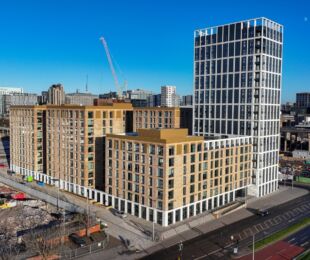
This project named ‘Het Dek’ (The Deck) is part of the first phase of the urban redevelopment of the Old Docks area in Ghent, Belgium, initiated by the OMA masterplan in 2005. The project sits in the center of a waterfront strip, organized by the historic quay with alternating building zones and green areas.Het Dek provides a mix of housing types and typologies. With 20% social housing and 20% budget housing, almost half of the residential stock of the new development aims at affordability. The quayside volume is conceived as stacked townhouses,
combined with apartments and bel-étage typologies on top of workshops and small retail units. The urban block sits on top of a 2 story underground volume, containing the central parking lot of the car-free district, as well as the installation for the water management system and the first green neighbourhood heat net, driven by bio gas from the composting of toilet waste and organic waste.
The building block encloses a green garden for water retainment on top of the underground parking, providing a collective garden for the surrounding housing units. Big Brick development BLAF architecten have been working on the development of the so called ‘Big Brick’: a facing brick with a large module (20/30/6 cm), allowing for the construction of self-bearing shells with facing bricks. BLAF is currently working on the technical approval of hybrid building systems, combining Big Brick with C02-negative bio based insulation and wood construction, resulting in 25% ceramic material reduction compared to the traditional cavity wall, and allowing for C02-neutral construction with facing bricks.
This project is a first step in the upscaling of the Big Brick application, using it for cold constructions. The brick slabs for the balcony structure along the quayside are built in Big Brick, allowing them to carry the span of the concrete terraces so they remain thermally and structurally independent from the insulated volume. They are an economic alternative for the full stone load bearing constructions with regular bricks.
The brick architecture suits the context of the old harbour, and allows for an economic and aesthetic architecture. The iconic red bricks are locally produced by the Belgian company Ploegsteert, and are the result of the cooking of one single type of local clay, with no additives whatsoever, resulting in a product with an exceptional pressure strength. The cooking process has been optimized to reduce CO2-emissions, and no extra cooking cycles for aesthetic post-production (like flashing or smoking) have been allowed. The position of the slabs results in a surprising articulation of the brick building along the quayside. The depth of the terraces
and the rhythmical composition of the Big Brick slabs provide the building with iconic and high quality private outdoor spaces, combining the structural and aesthetic qualities of the material. The Big Brick is conceived perfectly modular with the normal facing brick MF60, allowing for the combination of both in an almost invisible way.






